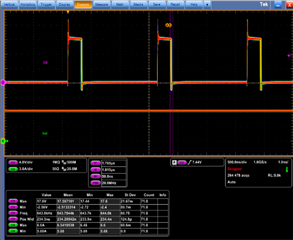Tool/software:
Hi Sir,
We want to check wether is the Jitter Criteria in this IC?
what' percentage for Jitter?
Does other condition be checked? (If the bode plot is pass.)
Thank you.
Vivian
This thread has been locked.
If you have a related question, please click the "Ask a related question" button in the top right corner. The newly created question will be automatically linked to this question.
Tool/software:
Hi Sir,
We want to check wether is the Jitter Criteria in this IC?
what' percentage for Jitter?
Does other condition be checked? (If the bode plot is pass.)
Thank you.
Vivian
what' percentage for Jitter?
Typically we would look for a pulse-width jitter greater than 25ns or 10% of the on-time, whichever is greater to verify the stability of the current regulation loop.
Since the primary concern for current loop stability is bi-modal operation where the pulse width alternate cycle by cycle two two distinct on-times, is can be practical to capture 4-6 switching cycles on an oscilloscope image and measure the pulse widths rather than using a long-term persistence measurement, which can be affected by operating condition changes and noise rather than loop stability.
Does other condition be checked? (If the bode plot is pass.)
Generally pulse width jitter, to verify current loop stability, and BODE plot measurements to verify voltage loop stability are sufficient.
It can also be helpful to capture a time-domain output voltage start-up (Soft-start) waveform, and transient response and recovery waveform, but the pulse width jitter and BODE are sufficient.
Hi Peter,
1. pulse-width jitter greater than 25ns or 10% of the on-time
-> does criteria be pulse-width jitter greater than 25ns or 10%?
2.capture 4-6 switching cycles on an oscilloscope image and measure the pulse widths
-->does it check 4-6 pulse width as the same?
Thank you.
Hi Vivian,
1. pulse-width jitter greater than 25ns or 10% of the on-time
-> does criteria be pulse-width jitter greater than 25ns or 10%?
The criteria for passing or failing will be based on whichever is greater: 25 ns or 10% of the on-time. For example, when Vin is 12V, Vout is 0.8V, and Fsw is 650 kHz, the on-time is about 100 ns. In this case, 25 ns is greater than 10% of 100 ns, which is 10 ns. Therefore, any jitter greater than 25 ns could be considered unstable.
2.capture 4-6 switching cycles on an oscilloscope image and measure the pulse widths
-->does it check 4-6 pulse width as the same?
You can measure the on-time of 4-6 pulses and calculate the average on-time. To get a jitter amount, subtract the highest and lowest on time.
For example, you have, let's say, measured on-time of 80ns, 90ns, 100ns, 110ns, and 120ns for five cycles. The average will be 100ns. The jitter will be 120ns - 80ns = 40ns. Since this is greater than 25ns, this will be considered a failure.
Thank you,
Tomoya
Hi Tomoya,
Below is our present measurement.
12V->1.8V
Frequency is 650KHz
(1/650KHz)*(1.8/12)=230ns
230ns*10%=23ns
Does it mean we get the fail result in below measurement?

Thank you.
Vivian.
Hi Vivian,
The nominal pulse width from the waveform is 234ns The minimum is 233.9ns the maximum is 234.4ns with a 124ps standard deviation
10% of 234 would be 23.4ns. The measured max - min = 0.5ns
0.5ns < 23.4ns, so yes, that is less than 10% of the nominal pulse width
Thank you,
Tomoya